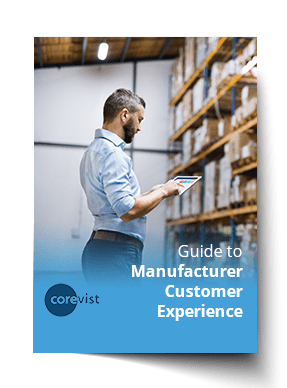Share
Author
George Anderson
Share
If COVID taught us one thing, it’s this: Customers don’t just want self-service. They actually need it.
This has become painfully clear for manufacturers. With staffing challenges affecting A/R processes, it’s become impossible to offer the level of customer service that buyers enjoyed before the pandemic. Customer portals are the answer—but many manufacturers struggle to define their entry point to the digital world.
So what should you prioritize if you’re looking to launch a B2B invoice portal?
Here are six keys to success.
1. Define a methodology for your project that includes the voice of the customer
If your B2B invoice portal is going to work for customers, you’ll need to incorporate their feedback into the project. Believe it or not, it’s insufficient to send them a survey ahead of time and run with their responses. You need to get their feedback on live, working software in the project phase.
So how do you get that feedback?
Here are the essential components of a customer-first methodology for launching your invoice portal.
- A project initiation workshop in which your internal stakeholders run through real business scenarios in the software and give feedback. Note: Prebuilt SAP integration is required so you can test with real data and real SAP logic.
- A sprint workflow for incorporating feedback from stakeholders into the software before the next workshop.
- A series of focus groups, first with internal stakeholders and then with customers, in which you iteratively refine the solution using the process above.
- A ruthless method for prioritizing critical value at GoLive without missing any deadlines.
Want more details? Check out this post: The Power Of Customer Collaboration In B2B eCommerce.
2. Look at adjacent customer tasks that increase the value of the portal
Customer interaction doesn’t start (or end) with invoices. In fact, that’s only one facet of the post-order phase of the customer journey. Invoices come from orders. And customers have questions about their orders.
For most manufacturers, the only way to provide these answers is through customer service reps. But imagine a portal that provides more than just invoices. How much would your organization save if you could turn all of these customer interactions into self-service within your invoice portal?
- Real-time status for full orders and individual line items, straight from SAP ERP
- Order tracking (including integration with major carriers for real-time updates on tracking numbers)
- Full order history from all channels (EDI, phone, fax, email, eCommerce…), straight from SAP ERP
- Change order capabilities within the B2B portal (if supported by your business processes)
Customers want to do all this and more in a digital B2B portal. Invoices are a key part of the self-service journey, but they’re not the whole picture.
You don’t have to stop with post-order care, either. A properly-architected B2B portal should support personalized catalogs and online ordering in addition to digital invoices and order tracking. Your platform should allow you to start with post-order care and give you the ability to scale up to B2B eCommerce when you’re ready. Look for a solution that lets you expand like this on the same SAP integration architecture.
Hint: This is what Corevist Commerce provides.
3. Consider your SAP integration carefully
A B2B invoice portal isn’t much good if it shows the wrong financial information (or out-of-date information). For manufacturers, that means real-time integration to SAP ERP is essential.
But how are you going to achieve this integration?
Even if you’re limiting your portal functionality to invoices alone, consider the integration points you’ll need to SAP ERP. Here’s a partial list.
- Integration point that returns invoice by invoice number (with support for restriction by user authorization).
- Integration point that returns invoice list by search criteria like payer, material, date range, delivery number, or order number. Restriction by user authorization required.
- Integration point that returns real-time open items from SAP ERP.
- Integration point that returns payment history.
- Integration point that pays open items via preferred payment methods (additional payment gateway integration required).
- Integration point that clears invoices in SAP in real time.
This is just a small sample of Corevist’s 53 prebuilt SAP ERP integration points that cover the entire buying journey for manufacturers’ customers. This functionality comes prebuilt in Corevist, and it’s configurable to your business processes. Without a prebuilt solution, you’ll have to build these integration points from scratch using a middleware or iPaaS (integration platform as a service) solution. That architecture gets unwieldy as time goes on and your organization accrues technical debt. It’s why we don’t recommend middleware-based solutions for SAP-integrated customer portals.
4. Get your data right in SAP
If you’re going to integrate your B2B invoice portal with SAP, then you’ll need to ensure your SAP system is ready for this kind of duty. You’ll want to ask yourself some pointed questions.
- Does our SAP configuration for A/R, invoices, and open items match our actual business processes 1:1?
- Is there any part of our A/R process that depends on tribal knowledge and isn’t reflected in SAP?
For some organizations, these questions are uncomfortable. They may expose an SAP configuration that doesn’t match your actual business processes.
For those organizations, the pressure to integrate with SAP can actually be a healthy thing. If customer interaction with your SAP data forces you to clean things up, that’s actually better in the long run—for both you and your customers.
We call this the Kimono Effect. It’s one of the added benefits of choosing a solution that includes deep SAP integration. Read more here: The Kimono Effect: Exposing SAP For eCommerce.
5. Evaluate your IT resources
SAP ERP integration isn’t for the faint of heart. It’s also not a great task for IT teams with limited resources.
Consider the requirements. Integrating your digital invoice portal to SAP doesn’t end on GoLive day. That’s just the beginning. If you rely on a middleware or iPaaS solution, you’ll have to maintain your business data and logic in three places (SAP, middleware, and the invoice portal). Three duplicate copies of your business data footprint provide plenty of opportunities for accruing technical debt. You’ll need to support, troubleshoot, and maintain your integration as long as you keep your invoice portal.
This is why Corevist exists. Our managed solutions include prebuilt SAP integration. You can launch the self-service customer portal you need without turning into a software development company.
6. Find a partner who fits your needs
Once you’ve defined your approach to SAP integration, you’ll need to find a partner who can support your plan. If you have the IT resources to handle SAP integration in-house, you can choose a partner and solution that don’t include SAP integration. Your options are more open here, as most solutions for B2B invoice portals don’t include SAP integration.
However, if you have limited IT resources and don’t want to take on that responsibility, you’ll need to look for a partner who offers managed solutions with prebuilt SAP integration.
The key is to identify your strengths as an organization—and your weaknesses. You don’t want those weaknesses to interfere with your customer experience in a digital portal. With the right partner on board, you can stick to your strengths while evolving your customer experience for the digital age.
NEW Resource:
Ultimate Guide to Manufacturer Customer Experience
Use these 5 keys to create a competitive customer experience in the digital age.










